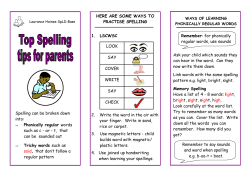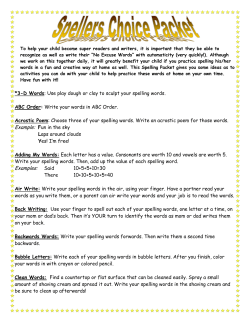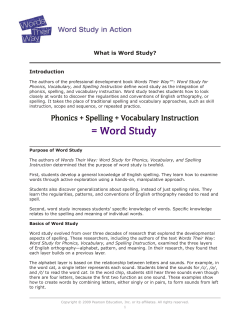
At home with spelling Helping your child learn to spell
At home with spelling Helping your child learn to spell For parents/carers of children in Kindergarten to Year 3 Learning about words Children learn about words in many different ways. When they’re very young, it’s often by experiences they share with you such as reading books or birthday cards, watching people write, and seeing words in and around the home and community. Over time children learn to recognise words, talk about letters and sounds, and connect them to their meaning. They learn to spell as they work out the patterns in the English language and apply them to new words. The 26 letters in the English alphabet stand for 44 different sounds. For example, the letter a makes a different sound in apple, apron, any and craft. 2 Spelling is important Learning to spell helps children with their writing. You can help your child gain confidence and skills with letters, words and spelling by trying some activities and games at home. There are many suggestions in this booklet covering three broad phases. As children progress at different rates these are a guide only. Some ideas are really quick and easy. For example, when you are making dinner say Find something in the kitchen which starts with the same sound as your name. Give it a go and help your child know that writing and spelling are fun, important and things to be proud of. Turn off the TV. It’s easier for your child to concentrate if there are no distractions. We are talking about the ‘Sea creatures’ story. 3 When your child begins school Your child will experiment with forming letters and learn that print carries a message. Have fun with your child from an early age playing games with letters and words. Just a minute or two, regularly, works best at this early stage. Try some of these ideas: • Read to your child – alphabet books, story books and birthday cards. • Read nursery rhymes again and again. Recite them together. • As you read to your child, point to words that are easily matched to a picture, such as cat or hat. • Help your child recognise their name. Start with just the first letter. Point it out when you see it in another word; write it; help your child trace over it with their finger while you say the letter. • Help your child print the letters in their name. Praise freely – it’s a big step to get little fingers to control a crayon! • Help your child to print labels for their things (books, games, toy box) to show that spelling has meaning. Learning to write is exciting. 4 • Play games with nonsense words, for example puppy schmuppy. • Display your child’s drawing and writing. It says I’m very proud of you! • Write letters on the steamed bathroom mirror and say the sound it makes (‘b’ as in boy) • Finger-write a big letter on your child’s back and ask which letter it is and what sound it makes. Let them write one on your back. • As you read talk about words together. For example, ask Which is the longest word on this page? or How is cat different from bat? • Help your child find words that rhyme in books such as those by Dr Seuss which you can borrow from the library • Look in a mirror so your child can see how their mouth moves. This can often help if they get certain sounds mixed up such as ‘f’ and ‘th’. Your child will love doing things with you and will enjoy talking about their successes. 5 As your child progresses through Year 1 Your child learns more about spelling and starts to understand the connection between sounds and letters. They’ll write the most obvious sound/s in a word, such as WT for went and KTN for kitten. You can help them to improve their skills by trying some of these ideas: • Use magnetic alphabet letters on the fridge or a magnetic board. Help your child make words. • Set up a home message board and write messages to everyone. • Encourage your child to write a message to you. • Write your shopping list in front of your child and talk about what you are doing. • Do a letter search with your child. Search for the letters of their name at home, in the garden, as you take a walk or travel. A m i n (ambulance, ants) (Marcus Street) (intersection, ice cream sign) (number plate) • Talk about signs you see in your community. For example, point out your street name so your child understands that words have a purpose. • Play rhyming games asking questions like What is cute, fluffy and rhymes with mitten? Let’s make a list together. 6 Make good use of junk mail Ask your child to: • circle words that have a certain letter such as ‘m’ or a sound like ‘sh’ • count how many times they can find a certain word such as ‘the’ – this helps them recognise common words • underline all the two letter words or three letter words and so on. Try re-arranging the letters in words to make other words. Ask your child to find some, starting with easy words and going on to harder ones. For example on no; dad add; art rat, tar; tabs bats, stab. These are called anagrams. The ‘m’ fits in the middle. 7 Building confidence in Years 2 and 3 As your child grows and progresses, they will be able to match letters with sounds quite well and develop a good bank of words they know how to spell. At this stage you can help your child to: • write when they play games such as playing school or shop • ‘have a go’ at spelling words before you tell them how • learn about a special interest to expand their vocabulary – animals, sport, science fiction. Help make lists of their favourite words. Read these regularly. • write each day for different reasons (lunch order, notes, lists, diary) • read their writing and underline any words they are not sure about, then check with you • read newspapers, magazines and comics as well as books – they all help build vocabulary and skill • play games such as Junior Scrabble® or Boggle® • play What word am I? You think of a word, such as holiday, and write one letter in the right place on the message board (_ _ l _ _ _ _). Your child guesses what the word might be. You can add another letter after each incorrect guess until they guess the word. • play Word detective. Ask your child questions like Which word rhymes with boat? or What word is opposite to long? • see how many words can be made from a word such as ‘together’ using only the letters in that word (he, get, greet, there, otter, other) What’s for lunch today? 8 • play Twenty questions. Think of a word your child needs to learn to spell. Your child can ask up to 20 questions to identify the word. For example, Does it have three syllables? Does it start with ‘t’? Can we eat it? • send you an email or reply to one you have written to them • make birthday and Christmas cards or party invitations. They will enjoy writing for a purpose. Get a colourful box and put in it anything that makes writing more fun – coloured paper, textas, coloured pencils, glitter glue and small stickers. • make thumb prints into cartoon characters, writing their conversations in speech bubbles • write to the local paper about an issue, such as cleaning up litter in the local park. See if you and your child can find words which read the same from the front or the back. For example, dad, pup and madam. These are called palindromes. We are making party invitations. 9 Tips for tackling tricky words Over time children will build a bank of words they know how to spell and will try new ones by sounding them out. You can help your child gain confidence by trying some of these tips: • Break words into chunks or syllables. To begin with clap as you say each syllable, for example birthday (birth/day = two claps); holidays (hol/i/days = three claps). • Look for little words in bigger words (believe = be, lie, eve; soldier = so, sold, old, die). • Sound words aloud as you spell. Talk about rules you use, explaining how they help you remember spelling. • When your child has tried a word, rather than telling them where they went wrong, write the correct word on a piece of paper and ask them to tell you what they got right and wrong. Shannon’s Game is great for using spelling rules and tactics. The letters have to be guessed in sequence. Start by writing the first letter of the word and a dash for each letter to follow (q _ _ _ _ ). Allow 10 guesses for each letter before giving the answer. Children soon learn that ‘q’ is usually followed by ‘u’ and that a vowel (a, e, i, o, u) will come next. As the word starts to take shape it gets easier to guess the rest (for example, quiet). This game gives you the chance to talk about the possible choices your child can make. We found lots of words starting with these letters. 10 Words on wheels When you are out and about, use the time to talk about words and play word games. We know what this sign means. • Play I Spy in the car or on the bus or train. • Make up short sensible sentences using the letters of number plates you see (BEO = Bob eats oranges; CPP = cuddly puppies play). • Read signs you see – for example, street and traffic signs. Point to a STOP sign and explain that the word says ‘stop’ and why it is important to stop there. This helps your child understand why correct spelling is so important. • Play word association games: someone says a word and the next person says another word that is connected with it and so on. For example: beach, fish, chips, seagulls, Eagles, football, Dockers. Word association games are fun! 11 Words on the web Some children are keen on computers which can be used to improve spelling skills. Computer programs often have animations or sounds that attract children and make learning fun. Help your child use the computer programs correctly and safely. Set up the computer screen to face into the room so you can see it too. There are many websites that have interactive spelling games for young children. You can try these, for short periods of time, or search for others: • amblesideprimary.com/ambleweb/lookcover/lookcover.html has an interactive game which uses a very useful spelling trick called Look, Cover, Write, Check. Your child sees the word, thinks about it, then the word is covered so your child writes it from memory. Then it is checked. • funbrain.com/spell/index.html Spell Check lets you choose an appropriate list; click on the wrong word then spell it correctly. • eduplace.com/kids/hmsv/smg/ lets you choose a grade and then asks you to click on the right word parts to make a complete word. • Visit www.det.wa.edu.au for lists of rules you can print as your child progresses and stick on the bedroom, toilet or fridge door. Remember to limit the time your child spends on the computer and place the monitor where you can see and share the games too. 12 What if my child makes a spelling mistake? First, talk about what your child has written before talking about the spelling. Praise what is right before suggesting any changes. Talk about what you do when you’re not sure how to spell a word, for example say I’m not sure. Let’s look it up. Talk about patterns in words, for example Both these words have ‘ing’ at the end. Ask your child to underline any words they’re not sure about. If your child asks you how to spell a word, you can simply tell them or you may ask them to have a go by saying What letter does it start with? Write what you think then I’ll help you. You can come back to those words when your child has finished writing. We can make words out of different materials. Good spellers are not perfect spellers. They will check if a word doesn’t look right. 13 What if my child struggles with spelling? • Speak with the teacher who will explain how your child’s spelling is progressing and discuss ideas to help your child. While your child is learning to write try not to focus too much on spelling. Sometimes this makes it less fun and they stop trying to write. • Be relaxed and patient – if your child feels you are rushed or frustrated, their anxiety will rise and confidence will drop. • Encourage writing. Practise often helps to build confidence. Keep examples of writing to show to family members and visitors. Take some to your work. 14 We make writing a fun time to spend together. What if my child speaks another language or dialect? Your child will need time to hear the sounds of the English language. It may take up to two years or longer for your child to hear and say all these sounds. Help your child hear the strong sounds at the beginning and end of words, such as stp for stop or cr for car. You can also help your child by showing them common spelling patterns such as ‘ed’ and ‘ing’. Help your child to keep a diary during holidays. Write something about each day. Write captions under photos. ‘E’ is for Ellie’s eggplants. 15 Handy hints Here are some easy tips to help improve spelling as your child progresses. Download posters to stick on the fridge with tips for spelling that even adults sometimes find tricky. Visit det.wa.edu.au/schoolinginwa and look for parent resources in At home with spelling. These tips include: Checklist Use this checklist to remind yourself of things to do to help your child have fun while learning spelling. Glance through the booklet every now and again to refresh your memory and get new ideas. • Apostrophes – to show when something belongs to one person/thing (the tail of the rat ➔ the rat’s tail) – to show when things belong to more than one person/thing (the toys of the boys ➔ the boys’ toys) – to show when letters have been left out of a word (can not ➔ can’t) • ‘e’ goes away when ‘ing’ comes to stay (hope ➔ hoping) • ’i’ before ‘e’ except after ‘c’ (chief, piece; receive, ceiling) • silent ‘e’ at the end of a word can change the vowel sound (cap ➔ cape) • Plurals (one pet – many pets; one class – many classes). I often read to my child. I talk to my child about words, letters and spelling. I encourage my child to look for letters or words when we go out. I play word games when we’re in the car/bus/train. I value and display my child’s writing. I encourage my child to ‘have a go’ at spelling new words. I encourage my child to write for pleasure. TITLE: At home with spelling : helping your child learn to spell SCIS NO. 1368304 ISBN 978-0-7307-4280-7 I ask my child to write for a special purpose. ©Department of Education and Training 2008 Reproduction of this work in whole or part for educational purposes, within an educational institution and on condition that it is not offered for sale, is permitted by the Department of Education and Training. Department of Education and Training 151 Royal Street East Perth WA 6004 910B/Jun/08 16
© Copyright 2025





















